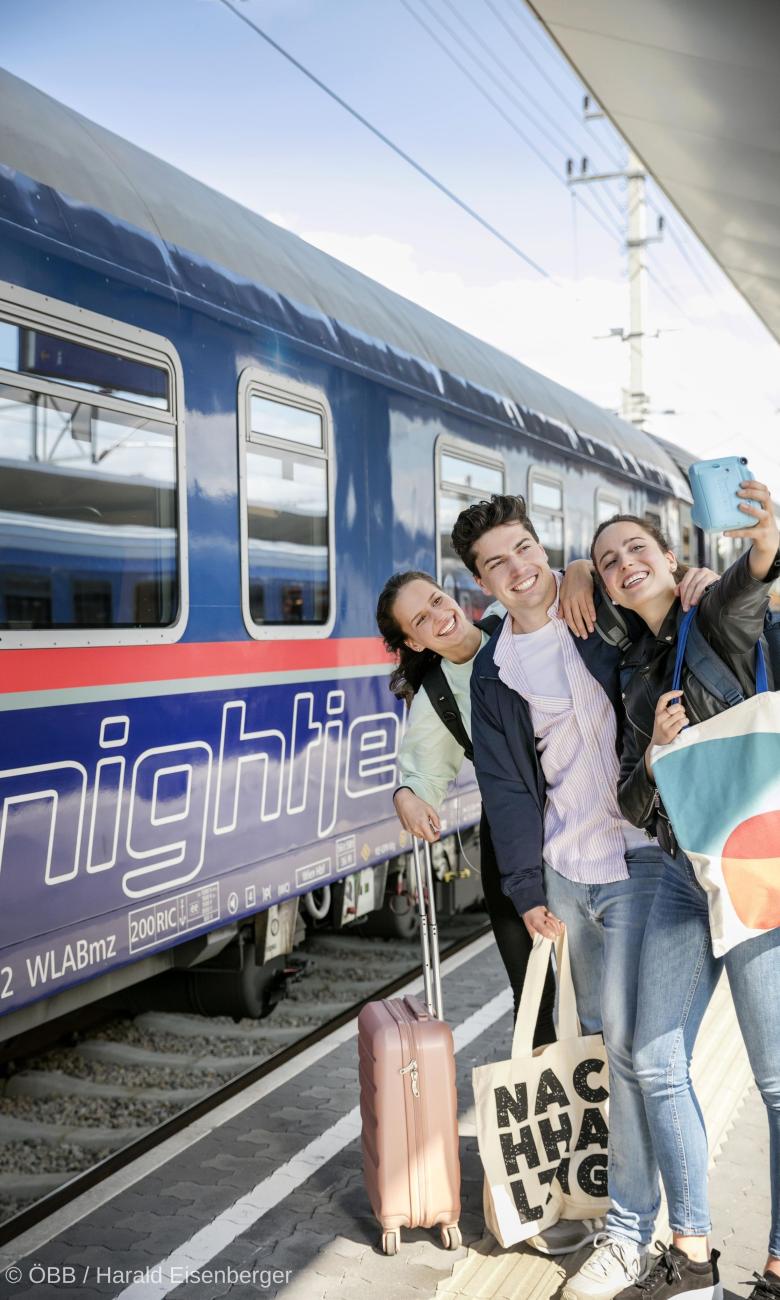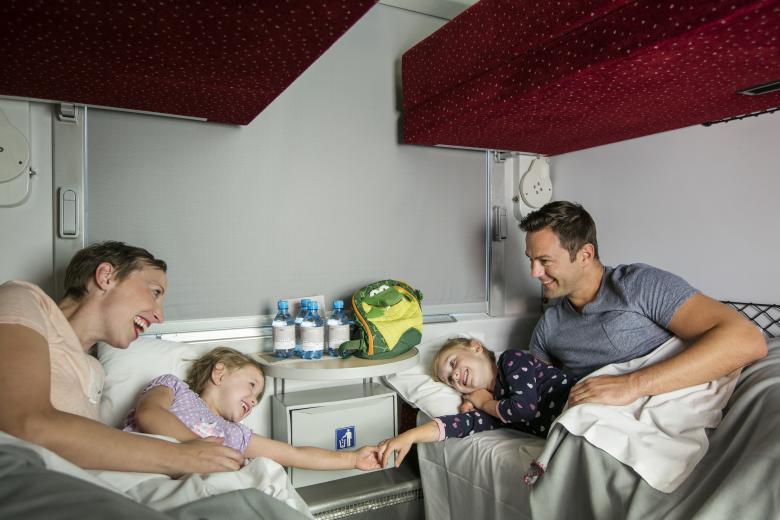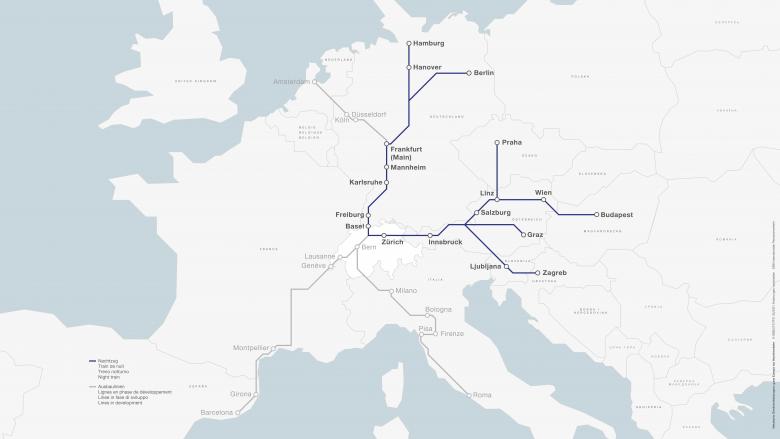Night trains – sustainability in style
It's certainly no secret that railways are the most environmentally friendly means of motorised transport. Yet the waning demand for night trains did not start making its comeback until relatively recently, with increasing environmental awareness and concerns about the planet's sustainability. It's easy to see where the travel trends are taking us: more and more people want a clear conscience included when reserving trips like the one from Zurich to Vienna.
Night trains have been around for a long time. The first sleeping cars are said to have run on the Cumberland Valley Railroad in Pennsylvania back in 1836 (Trbuhovic, 2002, p. 23) or 1838 (Papazian, 2011, p. 7). But now in particular is the time that they're headed to a new heyday, thanks to the climate movement and the trend towards travelling more sustainably. Demand for international overnight train services increased significantly in 2019; year-on-year, over 25 per cent more people took night trains (SBB AG, 2020).

In harmony with nature
Night trains transfer car and air travel to railways. Certainly, passengers are on the rails a bit longer than they would be in the sky. But they save on accommodation and shrink the trip's carbon footprint formidably. Indeed, Swiss Federal Railways (SBB) estimates that the currently operated night trains departing from Switzerland prevent 50,000 tonnes of CO2 emissions each year. This is roughly equivalent to the annual CO2 emissions of around 30,000 cars. (SBB AG, 2020)
For each railway route and sleeper train connection, travellers can easily calculate the exact amount of CO2 emitted and of energy consumed as well as how long the trip will take and compare all that to taking a plane or a car. You can see this for yourself at sbb.ch by putting in the route you'd like to take, clicking on the connection you want and scrolling down to see the Ecocalculator.
Here's an example: The total carbon footprint of an ÖBB Nightjet from Zurich to Vienna is 6.1 kilos of CO2. The same trip by car generates 138.6 kilos of CO2; by plane, a whopping 262.6. The biggest differences lie in nitrogen oxides emissions. These emissions are almost 63 times higher for planes (881.6 grams) than for trains (14).
Just for the sake of the planet?
The most sustainable trip is the one that you don't take. But travelling moulds us into who we are. It's often necessary, or worth longing for. It's an experience. That's why more and more people are looking for the most sustainable way to travel – and night trains present an ideal option. Racing over the rails overnight is fascinating and fills us with wonder. While it is a nostalgic blast from the past, it's also more than ever part of today's world.
Thanks to comfortable rolling stock, your overnight trip also feels almost like a stay in a lovely hotel room. Your welcome drink and snack are flanked by the mineral water and toiletries provided in the compartment, not to mention breakfast served up whenever you fancy (in sleeping cars).* And as if that weren't enough, most night trains take you straight from the heart of one city to the centre of another, saving you time and money and shrinking your carbon footprint even further.

Sleeper trains of the past and of the present...
the Orient Express and the legacy of a train that became an icon
Exotic, mysterious, shrouded in legend – for decades, the Orient Express was the fastest (night train) connection between Western Europe and Constantinople. The luxurious carriages welcomed royalty, magnates, arms dealers, spies... and last but certainly not least, a famous author who helped immortalise this unique train in the collective imagination with her no less famous mystery Murder on the Orient Express (Picon & Chelly, 2019, p. 152-177). This is what comes to people's minds around the world when they think of the Orient Express and marvel at it.
Yet not everyone may know about the company that operated the Orient Express at the time, the Compagnie Internationale des Wagons-Lits et des Grands Express Européens (CIWL), which was active not only throughout Europe, but also in Asia and North Africa (Picon & Chelly, 2019, p. 136-151). Some 90 years ago, the company owned the world's largest travel agency network (Picon & Chelly, 2019, p. 191), operating a fleet of nearly 2,400 carriages (Papazian, 2011, p. 34).
Can such a vast empire simply vanish into thin air? Of course not; the traces of this golden era of rail travel are everywhere you look. Travelling through Europe by train means living out a long and glorious tradition, which sometimes shows itself in fine details.
The Nightjet
The Nightjet is probably the best known sleeper train in Switzerland today, which raises the legitimate question: Where on this train are the traces of the golden era of rail travel? To get an answer, you have to do some digging and find out what became of CIWL. In the post-war period, it sold many of its carriages to various European railway companies, which founded an international sleeping car pool, later named Trans Euro Night (TEN), in 1971 (Papazian, 2011, p. 106). From then on, CIWL diversified its business activities into tourism services (Mühl & Klein, 2006, p. 265). In 1991, the firm was acquired by the French hotel group Accor (Mühl & Klein, 2006, p. 265), which sold its travel agency division Carlson Wagonlit Travel in 2006 (mycwt.com, 2021). This was followed in 2010 by the acquisition of the rail services division by the catering group Newrest (newrest.eu, 2021), which has since been operating as Newrest Wagons-Lits (newrest.eu, 2021).
Newrest Wagons-Lits bears the DNA of the historic CIWL and provides on-board services for ÖBB on its Nightjet trains, thus carrying forth a tradition whose roots date back some 150 years. And while today's Nightjets may not have the Haviland porcelain, Christofle silverware and Baccarat crystal glasses of yesteryear's Orient Express (Picon & Chelly, 2019, p. 62), they do feature high-quality catering for affordable prices and help make overnight rail travel accessible to more people than just the crème de la crème.
Although the company that operated the Orient Express at the time lives on under a different moniker, the Orient Express does not. Still, the last journey of the legendary palace on wheels lies in the quite recent past. The Orient Express vanished from timetables in the night from 12 to 13 December 2009, when it took to the tracks leading from Strasbourg to Vienna for the last time, as EuroNight 469 with ÖBB rolling stock (seat61.com, 2021). This stock was a sign of how the Orient Express morphed over the decades following the Second World War, abandoning its character as a luxury train (Koschinski, 2008, p. 59-72).
... and the future
Night trains have a clearly demonstrable positive impact on the planet's climate. To help further reduce CO2 emissions in the travel sector, SBB and ÖBB, among other companies, are pursuing the common goal of transferring more travel to railways. To this end, the two companies want to invest heavily in expansion plans and have signed a letter of intent – night train services are to be expanded from six to ten lines. Other railways such as SNCF and Deutsche Bahn have now joined them. From December 2021, there will once again be a Vienna–Paris night train, and the former Orient Express route will also receive a new lease of life.
Scaling up northbound capacity
The first step in Switzerland will be the new night train connection between Zurich and Amsterdam, which will begin operating in 2022. Demand is also increasing for the already existing connections from Berlin and Hamburg to Zurich, via Basel. Additional separate trains will significantly increase capacity on these lines. This step is scheduled to already start in 2023.
Furthermore, the connection to Prague will now also pass through Germany. The changes to this route create new direct connections to Leipzig and Dresden.
Night trains to Barcelona and Rome
Next on the horizon are the plans for daily connections from Zurich to Barcelona via Bern, Lausanne and Geneva, and vice versa. This will not only embed an additional European metropolis, but also the western part of Switzerland into the network of night trains. There are parallel plans to relaunch the Rome–Zurich line.
The exact launch date for these two lines has not yet been set in stone.

Investing in new rolling stock.
The ÖBB is also investing in new rolling stock in order to secure the medium and long-term expansion of the night transport network. The new night train sets are to be phased into operation step by step. They are expected to also be deployed more in Switzerland from 2024.
There is one potential stumbling block, however: the service expansion was planned under the assumption of financial support from Switzerland's proposed climate fund. Following the rejection of the CO2 Act by popular vote on 12 June 2021, this funding is no longer available. It is not yet known what effects this will have on the expansion plans, though there is hope that politicians will soon find alternative financing solutions to allow the further development of this climate-friendly means of transport.
Article by Swiss Travel System AG and SBB AG
Bibliography
(3 giugno 2021). Tratto da mycwt.com: https://www.mycwt.com/why-choose-us/our-company/our-history/
(3 giugno 2021). Tratto da newrest.eu: https://www.newrest.eu/country/austria/
(3 giugno 2021). Tratto da newrest.eu: https://www.newrest.eu/who-we-are/our-history/
(3 giugno 2021). Tratto da seat61.com: https://www.seat61.com/history-of-the-orient-express.htm
Koschinski, K. (2008). Klangvolle Namen, verblasster Glanz. Eisenbahn Journal - 125 Jahre Orient-Express, p. 59-72.
Mühl, A., & Klein, J. (2006). Reisen in Luxuszügen - Die Internationale Schlafwagen-Gesellschaft. Freiburg: EK-Verlag.
Papazian, A. (2011). Hotel auf Schienen - Nachtzüge in Europa. Stuttgart: transpress Verlag.
Picon, G., & Chelly, B. (2019). Der Orient-Express - König der Züge. München: Frederking & Thaler Verlag GmbH.
SBB AG. (15 September 2020). company.sbb.ch: https://company.sbb.ch/de/medien/medienstelle/medienmitteilungen/detail.html/2020/9/1509-1
Trbuhovic, L. (2002). Schlafwagen im Wandel. Zürich: unpublished manuscript.




